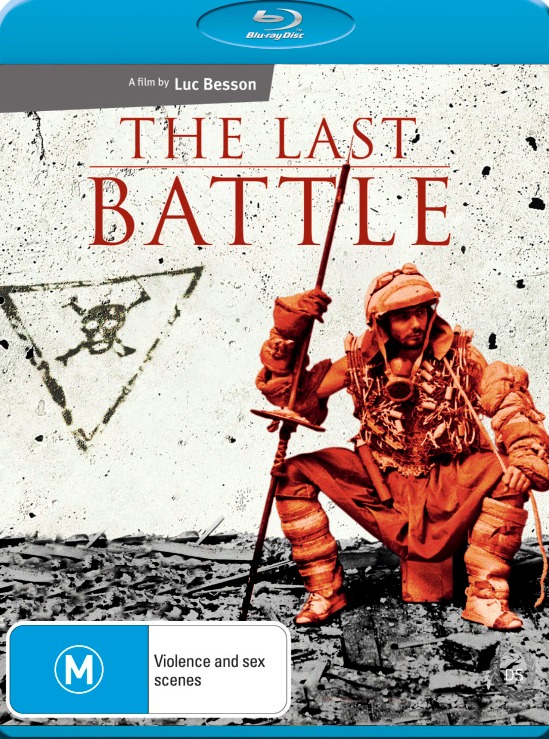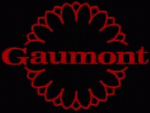Last Battle, The (Le Dernier Combat) (Directors Suite) (Blu-ray) (1983) |
|
Last Battle, The (Le Dernier Combat) (Directors Suite) (Blu-ray) (1983) |
|


|
| BUY IT |
| General | Extras | ||
| Category | Science Fiction |
Main Menu Audio & Animation Theatrical Trailer |
|
| Rating |

|
||
| Year Of Production | 1983 | ||
| Running Time | 92:40 (Case: 90) | ||
| RSDL / Flipper | No/No | Cast & Crew | |
| Start Up | Menu | ||
| Region Coding | 4 | Directed By | Luc Besson |
|
Studio
Distributor |
 Madman Entertainment |
Starring |
Pierre Jolivet Jean Bouise Fritz Wepper Jean Reno Christiane Krüger Maurice Lamy Pierre Carrive Jean-Michel Castanié Michel Doset Bernard Havet Marcel Berthomier Petra Müller |
| Case | Standard Blu-ray | ||
| RPI | $39.95 | Music | Eric Serra |
| Video | Audio | ||
| Pan & Scan/Full Frame | None | French Linear PCM 96/24 2.0 | |
| Widescreen Aspect Ratio | 2.35:1 | ||
| 16x9 Enhancement |
 |
||
| Video Format | 1080p | ||
| Original Aspect Ratio | 2.35:1 | Miscellaneous | |
| Jacket Pictures | No | ||
| Subtitles | English | Smoking | Yes |
| Annoying Product Placement | No | ||
| Action In or After Credits | No | ||
Watching a brilliant feature film from a debut director is always such a delight; I can’t help but think there are many masterpieces to come from South African director Neill Blomkamp who wrote and directed the exceptional District 9 (2009) and was named one of the ‘100 Most Influential People of 2010’ by Time magazine (read Ridley Scott's editorial here), or British director Duncan Jones, who directed the sublime Moon (2009) which rightly received many International film prizes.
Luc Besson, at age 25, was equally also highly regarded upon the release of his feature film debut Le Dernier Combat (1983); he not only received a nomination for the Cesar award for ‘Meilleure première oeuvre’ (Best First Work) the French equivalent of an Academy Award nomination, but by the end of the 1980s he was widely credited with revolutionising modern French cinema and regarded as the part of the ‘Cinema Du Look’ movement, alongside Jean-Jacques Beineix and Leos Carax. Besson co-wrote Le Dernier Combat with lead actor Pierre Jolivet and it was expanded from the short film L’avant dernier (1981) which also starred Jolivet, Jean Reno (who also appeared in Le Dernier Combat) and Fabice Roche.
In many contemporary essays on Le Dernier Combat, the ambitious science fiction-western has often been unfairly linked to George Miller’s influential Mad Max (1979) as both films share a ruined dystopian landscape and subsequent gang violence. I however would argue that these are the lone similarities between the post apocalyptic films as the ‘heroes’ in each respective feature films are wildly different. For example “Mad” Max Rockatansky is a Main Force Patrol officer, whose murderous actions are the result of revenge killings and he remains an anti-hero by the conclusion of the feature film; he is the embodiment of the triumph of good over evil. In comparison the audience never really gets to know the ‘hero’ of Le Dernier Combat. He is only credited as ‘The Man’ and he is revealed to the audience, certainly not as tough or skilled ala Mad Max, instead he appears to just need, what he needs – in this case a real woman instead of the dissatisfying blow-up doll he has. ‘The Man’ lives an isolated existence in the few decrepit buildings which still occupy the bare landscape, which has been destroyed by an undeclared disaster. There are indications of an environmental disaster as the skies are no longer stable and it can suddenly rain fish or stones at any given time. The audience also soon learns that mankind no longer can speak and without any form of technology the few men who occupy the desolate land have to revert to savage and primitive ways. ‘The Man’ is no different; he has to do, what he has to do, even if that means cheat, steal and commit murder if necessary, it’s all a matter of survival.
However ‘The Man’ serendipitously meets ‘The Doctor’ (Jean Bouise) who attends to the ‘The Man’s’ wounds and the two begin to form a genuine friendship. It is revealed ‘The Doctor’ is protecting (or is holding prisoner) the lone woman who occupy’s the landscape. Curiously ‘The Doctor's’ motivation is never clearly stated, she could in-fact be his daughter. ‘The Brute’ (Jean Reno) knows of the woman’s existence and while ‘The Doctor’ seems to have taken a shine to ‘The Man,’ ‘The Brute’ isn’t going to give up without a fight, as he too desperately wants to pro-create with the protected/imprisoned woman. It seems ‘The Doctor’ is playing some form of a matchmaker role, (he also paints cave images of Adam and Eve) and a ‘battle’ of wits and strength inadvertently develops between ‘The Man’ and ‘The Brute.’
What’s unusual for the film is that Besson’s ‘The Man’ is hardly a heroic figure; he is just an ordinary ‘man’ and is unlike the prolific protagonists who are often found in the science fiction genre, as he is not trying to improve or evolve from the situation he is just coping day to day with the usual human frustrations. Equally Besson is toying with the science fiction landscape, removing the ability to communicate and any form of working technology and as everything is broken and destroyed, it can only be temporarily fixed, leading to more frustrations. As a feature film debut Le Dernier Combat demonstrated Besson’s ability to depict the humanity of his characters by building drama upon their situation; he is interested in their loss and their subsequent isolation, their own personal struggles as opposed to their actions. The empty world of Le Dernier Combat is without religion or without social and political order and it depicts everyman for himself and women as a possession and a commodity. It’s a pretty dire situation yet the feature film is also filtered with black comedy, particular in the slapstick scenes between ‘The Man’ and ‘The Brute.’ The feature film demonstrated a youthful Besson’s talent to create intelligent and engaging narratives and his then developing innovative visual style. Besson, it seems, was always destined to be a prolific, challenging and ground-breaking filmmaker.
The limited budget did not deter a young Besson from making a visually arresting feature film, which was filmed on location in Paris and Tunisia. Originally filmed in Black and White, Le Dernier Combat appears in the original 16x9 enhanced, 2.35:1 aspect ratio on a Blu-ray 25 Disc.
The feature film is produced quite nicely on Blu-ray as the 1080p AVC transfer remains overall detailed and precise, yet due to the film’s age there are a fair few film artefacts, incidents of chroma and minor incidents of print damage, but certainly nothing severe enough to distract from the viewing experience.
Being a black and white feature film, the monochrome palette is rendered stark and raw and as the contrast is strong, the whites appear ‘hot’ while the blacks appear 'crushed' at times; but again this is a minor issue as the Blu-ray presentation certainly surpasses any previous DVD presentations. Also a fair amount of grain is evident throughout the feature film, but I didn’t mind it and it also did not distract from the viewing experience. Edge-Enhancement is also apparent on occasion.
| Sharpness | |
| Shadow Detail | |
| Colour | |
| Grain/Pixelization | |
| Film-To-Video Artefacts | |
| Film Artefacts | |
| Overall |
There is no dialogue in this feature film, bar one scene. As such the soundtrack is composed solely of atmospheric sounds. The French LPCM 2.0 soundtrack, given it was produced in the 1980s is adequate; it is clean and features no incidences of hissing or distortion. The soundtrack isn’t particularly immersive due to the nature of the film. Le Dernier Combat was Eric Serra’s first feature film soundtrack (it is not used extensively in the feature film) and it is very much stuck in the 1980s, developed from the new wave synthpop sound.
| Dialogue | |
| Audio Sync | |
| Clicks/Pops/Dropouts | |
| Surround Channel Use | |
| Subwoofer | |
| Overall |
Animated menu with scenes from the feature film, featuring Serra’s soundtrack. Twelve scene sections and access to the lone extra feature.
The Theatrical Trailer was created for a 1992 re-release of Le Dernier Combat referring to Besson’s subsequent feature films Subway, Le Grand Bleu and Nikita. The trailer is subtitled in English.
NOTE: To view non-R4 releases, your equipment needs to be multi-zone compatible and usually also NTSC compatible.
The Madman Blu-ray release is identical to the UK Optimum Blu-ray release.
Le Dernier Combat is a classic sci-fi-western which makes for excellent viewing particularly considering recent releases in the post-apocalyptic genre The Road (2009) and The Book of Eli (2010). Le Dernier Combat is also a highly recommended to fans of Luc Besson. The Madman Blu-ray is overall a satisfactory effort and it is a great addition to the Besson ‘Directors Suite’ Blu-ray range – all that is needed now is Joan of Arc (1999) and Angle-A (2005).
| Video | |
| Audio | |
| Extras | |
| Plot | |
| Overall |
| Review Equipment | |
| DVD | Panasonic DMP-BD35 Blu Ray Player, using HDMI output |
| Display | Mitsubishi Electric HC6800 1080P Home Theatre Projector. Calibrated with THX Optimizer. This display device is 16x9 capable. This display device has a maximum native resolution of 1080p. |
| Audio Decoder | Built in to amplifier/receiver. Calibrated with THX Optimizer. |
| Amplification | Onkyo TX-SR800 |
| Speakers | (Front) DB Dynamics Polaris AC688F loudspeakers,(Centre) DB Dynamics Polaris Mk3 Model CC030,(Rear) Polaris Mk3 Model SSD425,(Subwoofer) Jensen JPS12 |